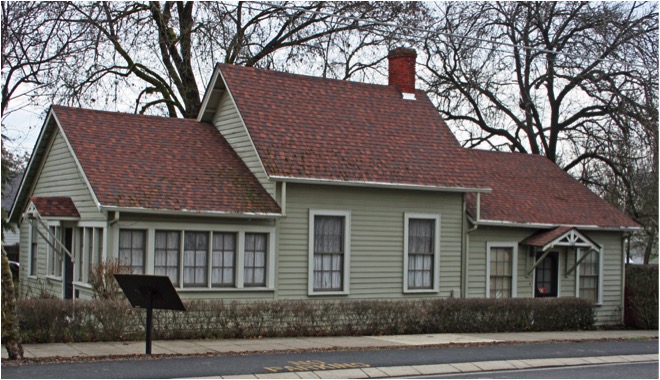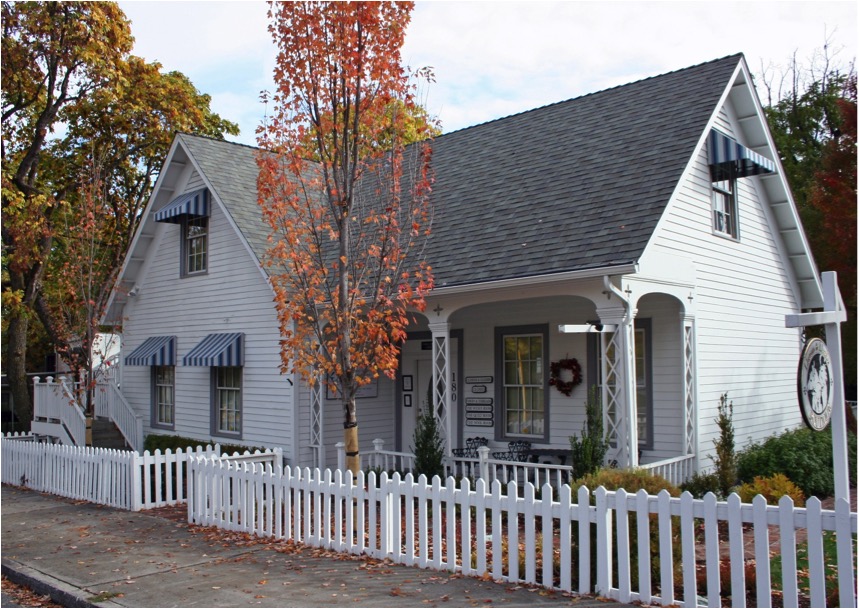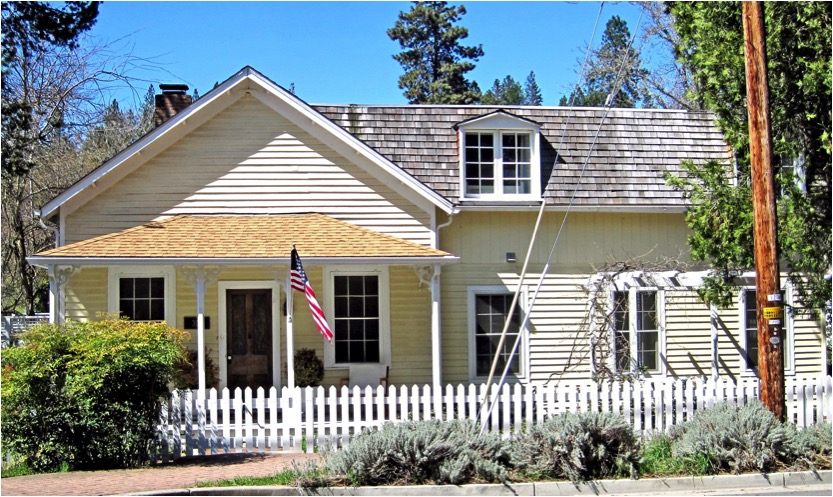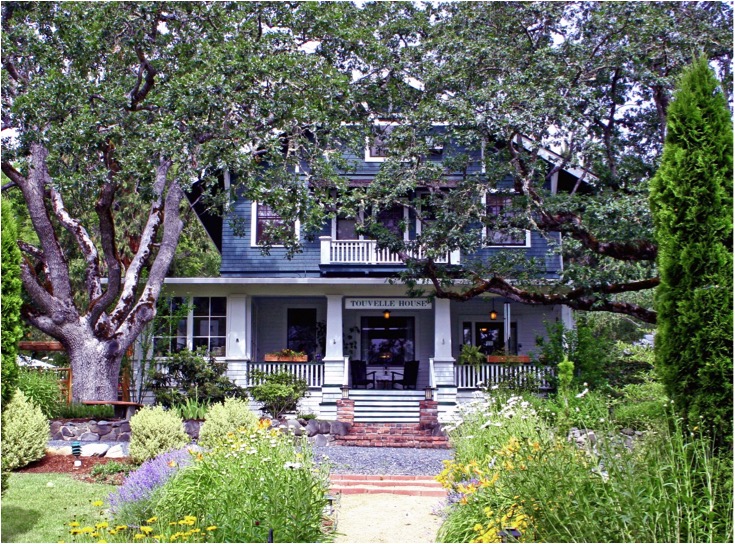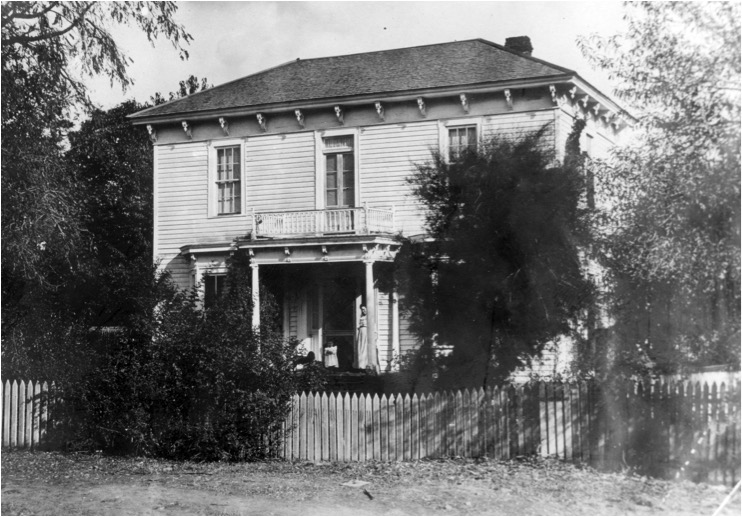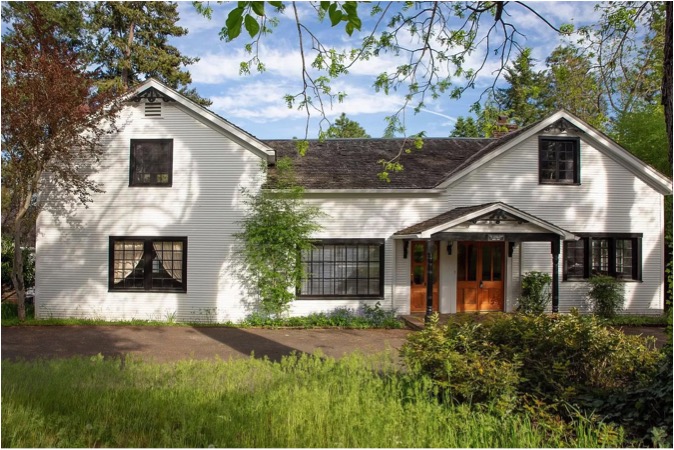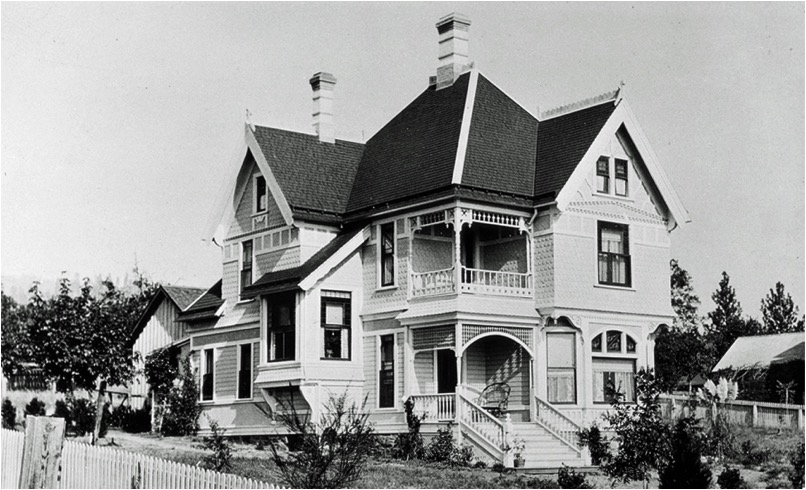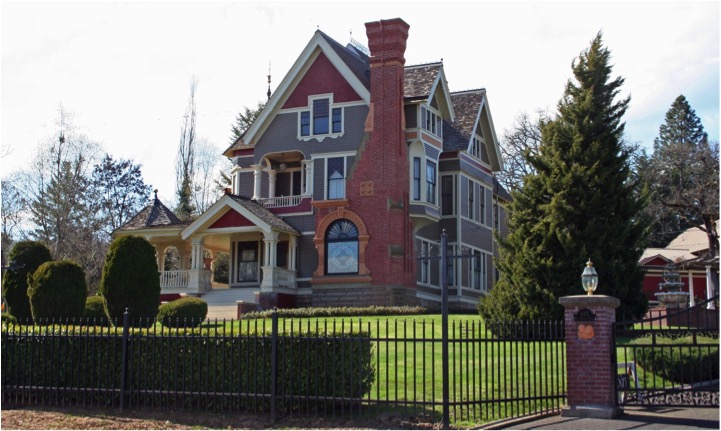Our “Walk through History” video gives you a great 30 minute overview of Jacksonville, Oregon’s storied history, but if you want to dig a bit deeper –
and visit sites not included in the video – then explore this
“Walk through History” blog!
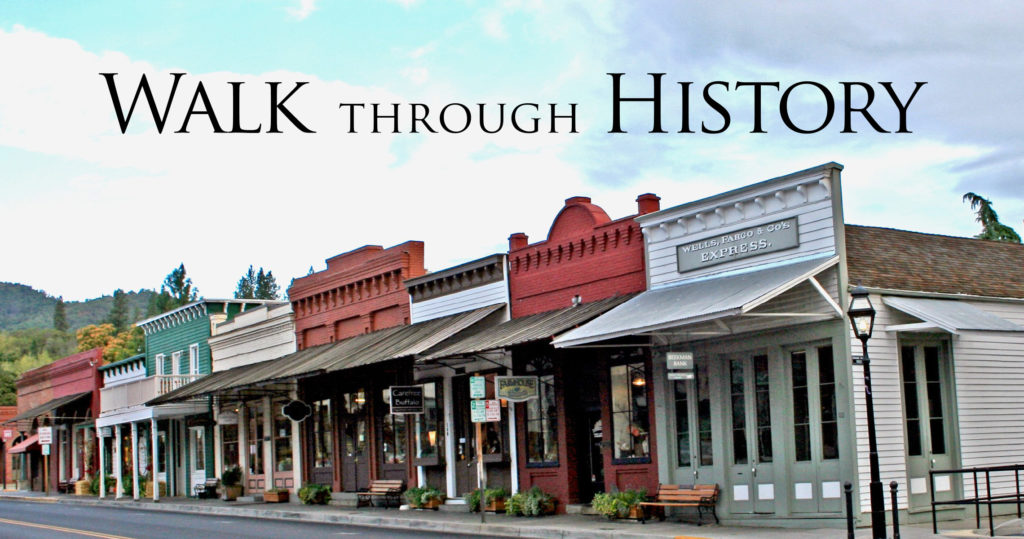
Want to know more about Jacksonville’s oldest residential structure still standing?
Or the town’s landmark Queen Anne style Nunan house?
Did you know Jacksonville boasts the oldest Protestant church in Oregon –
maybe the oldest Protestant church west of the Rockies?
How about some of the town’s reputed 36 saloons?
Jacksonville, Oregon was Southern Oregon’s 19th Century governmental, commercial and social hub! Just click on an historic site in our menu to the left where we share stories about the history of the buildings and the people who occupied them –
a lot more informative than a building plaque with its name and date.
And we are continually adding more sites!
You can also have a quick sample of individual locations through our daily Facebook and Instagram posts. Or enjoy video tours of even more historic sites through our “Step Back in Time” video series.
Choose your time.
Choose your specific interest.
And join Historic Jacksonville, Inc. as we explore the history of businesses, fraternal orders, churches, and homes from the discovery of gold to the coming of the railroad.
|
Stop #1 – The Jackson County Courthouse -Jacksonville City Hall |
|
The imposing two-story brick and stone Italianate courthouse that is now Jacksonville’s new City Hall was formerly Jackson County’s historic courthouse. It was declared the crowning glory of Jacksonville when it was constructed in 1883-84. Read more. |
|
Stop #2 – The Historic Jackson County Courthouse –Trial of the DeAutremont Brothers |
|
On Thursday, October 11, 1923, as Southern Pacific Train Number 13 emerged from Tunnel No. 13, the three DeAutremont brothers stopped it … Read more. |
|
|
|
The second jail structure was built in 1875, a sturdy brick building reinforced with “4,000 pounds of iron spikes for strength.” Seven inch thick wooden planks lined the masonry walls and separated the cells.2 While these improvements didn’t stop the escapes,3 … Read more. |
|
|
|
The Methodist Episcopal church building at 305 North Fifth Street, now St. Andrew’s Anglican Church, is one of a handful of churches claiming the title of “Oldest Protestant Church West of the Rockies.” It certainly was the first church built in Southern Oregon and is the oldest church building in Oregon in active use for church services.1 It is also the oldest original wooden building in Jacksonville. … Read more. |
|
|
|
Our next stop is St. Joseph’s Catholic Church, at 280 North Fourth Street in Jacksonville. Shortly after the discovery of gold here in 1852, Rev. James Croke celebrated the first Catholic mass in town at the home of Charles Casey.1 In 1855, Father Croke reported to his Archbishop that he had counted 105 Catholics in the Rogue Valley alone, and in 1858, town founder James Clugage again came through for the religious community, deeding this parcel of land for the use and benefit of the Catholic Church in exchange for $5. … Read more. |
|
Stop #6 – Historic Presbyterian Church |
|
Let’s wrap up the “houses of worship” portion of our virtual tour with a stop at the historic Presbyterian Church at the corner of California and 6th streets. One of the most beautiful churches in the valley, this church was the culmination of the hopes of the small contingent of Presbyterians in Jacksonville led by William Hoffman. For many years prior to its construction, they had been holding their services in the Methodist church, the local school, and homes. Pioneer William Hoffman, his wife Caroline, and their six daughters came across the Oregon trail in 1853 from Indiana to Jacksonville. … Read more. |
|
Stop #7 – Amanda and John Bilger House |
|
Let’s head over to 540 Blackstone Alley, the site of the beautiful Bilger House. This is a private residence, so we’ll be sure to respect the privacy of the current occupants. You might say they won’t even know we’re here. As you can see from the photographs, this home is a two-story of brick construction, one of the first brick private homes in Jacksonville, and was completed in about 1863 by Patrick Fehley and our old friend, David Linn…. Read more. |
|
Stop #8 – B.F. and Anna Dowell House |
|
From Blackstone Alley and the Bilger House, let’s make a right on East F Street and walk one block to the intersection of East F and North Fifth. The majestic Italianate structure at 470 North Fifth Street was the home of Benjamin Franklin Dowell and his family. Benjamin Franklin Dowell, named for his famous ancestor, built this house in 1861, and as you can see from the first photo, it originally had a flat roof. While most homes in Jacksonville at that time were heated by stoves, … Read more. |
|
Stop #9 – Obenchain/Lewis/Keegan House |
|
Next, we’ll head across Fifth Street two blocks to Third and D and the Minnie Obenchain Lewis/Chris Keegan House at 105 East D Street. A later addition to the homes here in Jacksonville, this rectangular one-and-a-half storied wood frame house was constructed around 1908. It is one of only four residences in Jacksonville with board and batten exterior sheathing. Neither the builder nor the architect is known. … Read more. |
|
Stop #10 – Matthew G. Kennedy House |
|
Let’s turn left now and walk down to the Matthew G. Kennedy House at 240 North Third Street. This is believed to be Jacksonville’s oldest residential structure still in existence. The original portion of the house is believed to have been constructed in 1855, and no later than 1856. The eastern addition was made in the late 1880’s and was used as a summer kitchen. The front porch was likely added at that same time. … Read more. |
|
Stop #11 – Thomas Kenney House |
|
While we make our way to our next stop, let’s talk a bit about the family who made their home there. Daniel Moe Kenney arrived Jacksonville in early 1852. Shortly thereafter, James Clugage , one of the town’s founders, gave Kenney the lot on the northeast corner of California and Oregon Streets, where Kenney opened the town’s first store with a man named Appler. … Read more. |
|
Stop #12 – Gustav and Johanna Karewski House |
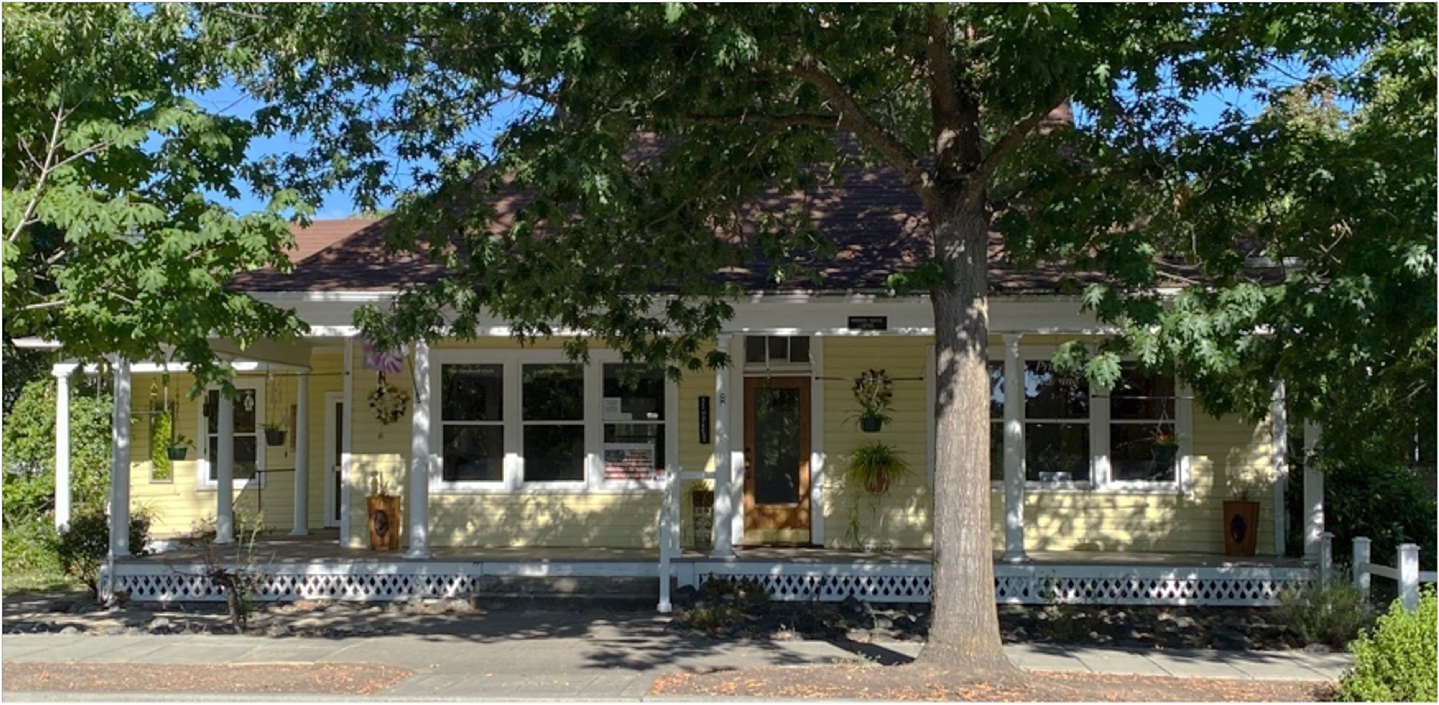 In October 1866, Dr. E.H. Greenman purchased the northwest corner lot at California and North 5th Streets from C.C. Beekman. By 1868 Dr. Greenman was the county coroner (which makes for a good story if this were the Haunted History tour) and had bought additional lots in the block. That same year Dr. Greenman erected a rectangular home on the present site, the core section of what is known as the Karewski house. … Read more. In October 1866, Dr. E.H. Greenman purchased the northwest corner lot at California and North 5th Streets from C.C. Beekman. By 1868 Dr. Greenman was the county coroner (which makes for a good story if this were the Haunted History tour) and had bought additional lots in the block. That same year Dr. Greenman erected a rectangular home on the present site, the core section of what is known as the Karewski house. … Read more.Back to top |
|
Stop #13 – Max and Louisa Muller House |
|
Like Gustav Karewski, Max Muller came to Jacksonville from Germany, married, raised his children and made his life here. His home at 465 East California is our next stop. This lovely Italianate-style home (or, according to some sources, “High Victorian Italianate”) was built in 1887. It is one of the few surviving homes in the (James) Poole and (Henry) Klippel Addition to Jacksonville, platted in 1868. In 1883, Max Muller bought the lot with an existing small house from Edwin Smith. … Read more. |
|
Stop #14 – Thomas G. and Lucinda Reames House |
|
Almost directly across the street from the Max and Louisa Muller house (Stop #13) was the home of the Thomas and Lucinda Reames family at 540 East California Street. While many details are characteristic of the Queen Anne style, the earliest portion of the house was probably constructed around 1864 and consisted of a simple rectangular structure with a north facing porch across its length. As Reames prospered and grew in prominence, the house grew along with his public stature and family size. … Read more. |
|
Stop #15 – Cornelius C. Beekman House |
|
Let’s walk across Laurelwood to 470 E. California Street and the 1873 home of Cornelius C. Beekman. Beekman and Reames were not only neighbors, they were also business partners until Reames’ death in 1900. With the Beekman House, the Reames House, the Muller House and other California Street homes no longer standing, we are on Jacksonville’s pioneer equivalent of “millionaires’ row,” homes of self-made men who built their fortunes in Jacksonville. … Read more. |
|
Stop #16 – St. Mary’s Academy and Beekman Square |
|
Let’s stroll a block west on California Street to another site with Beekman’s name on it—Beekman Square—which, ironically, was never part of Beekman’s property. This time we’re paying a virtual visit to a virtual site—the second home of St. Mary’s Academy. St. Mary’s Academy was established in 1865 after Rev. Francis Xavier Blanchet, priest of St. Joseph’s Catholic Church (Stop #5), asked the Sisters of the Holy Names of Jesus and Mary to open a school in Jacksonville. In August of that year, Sister Mary of the Seven Dolores, Sister Mary Febronia, and Sister Mary Zotique arrived from their convent in Montreal. … Read more. |
|
Stop #17 – G. W. Cool/Minerva Armstrong House |
|
The saltbox style was popular during the Colonial period and an architectural staple in New England where dead space under the eaves provided insulation during the cold winters and a sloping roof line shed excess snow. Saltbox architecture was seldom seen west of the Mississippi, and, although this 1858 structure does incorporate some Classical Revival features, this was the only “saltbox” built in Jacksonville to our knowledge. Known as both the G.W. Cool House and the Minerva Armstrong House, its provenance is somewhat murky. … Read more. |
|
|
|
Let’s cross back over East California Street and walk a few doors west to the 1893 Queen Anne style house at number 390. It’s known as the DeRoboam House, and some people think it belonged to Jacksonville’s well-known hotel proprietress, Madame Jeanne DeRoboam Holt, who owned both the Franco-American Hotel and the U.S. Hotel. However, the DeRoboam in this case was her brother, Jean St. Luc DeRoboam—or more accurately, her brother’s second wife, Henrietta Schmidling DeRoboam. And there is quite a back story to this structure! … Read more. |
|
|
|
Let’s continue west across South 5th street to the 2-story Classical Revival-style McCully house at 240 E. California Street. When it was completed in December 1861 by builder Ludwig Hartwig, it was one of the most expensive and palatial residences in Jacksonville—based on the number and value of the liens placed against the house for John McCully’s indebtedness! Both John Wilmer McCully and his wife Jane Mason McCully were influential figures in the commercial and cultural development of Jacksonville. They were among the first settlers to arrive in Jacksonville in 1852 following the discovery of gold. … Read more. |
|
Stop #20 – John Miller House(s) |
|
Our next stop is an interesting combination of virtual and real—and the two are so different that it’s hard to believe we’re talking about the same house. Let’s turn left on South 4th Street and then right on East Main and proceed to the corner of South 3rd Street and the John Miller House. This one-story ranch style building that now serves as commercial office space housed Jacksonville’s City administrative offices for almost 40 years prior to their relocation to the historic Jackson County Courthouse (see Stop 1). But once upon a time, this same structure was an elaborate Queen Anne style home!… Read more. |
|
|
|
This two-story Italian Villa style home was constructed in 1880 for John Orth, Jacksonville’s most successful early butcher. The Orth family had occupied a simple wooden home on a portion of the 105 West Main Street site for the previous 15 years. In 1872 Orth had erected an impressive two-story brick commercial building on South Oregon Street which still bears his name and will be our next stop. Now it was time to accommodate his growing family in a similarly appropriate manner. … Read more. |
|
Stop #22 – John Orth Commercial Building |
|
Now that we’ve visited John Orth’s residence, let’s head a block west and see Orth’s commercial building at 150 South Oregon Street. Orth apparently liked the Italianate style of architecture since he chose it for both business and residence. His 1872 commercial building is essentially a two-story brick block with arched ground floor and rectangular second floor windows and doors, separated by pilaster strips. Original drawings show a triangular pediment adorning the roof line. The architect and builder are unknown. … Read more. |
|
Stop #23 – J. A. Brunner Building |
|
Our next stop, the J.A. Brunner Building, is quite literally joined at the hip with its neighbor, the Orth Building. In fact, the ground floors share a wall, and the south wall of the second story of the Orth building rests on the north wall of the Brunner Building. The 1855 Brunner Building was the second brick building constructed in pioneer Jacksonville. It is the oldest surviving brick building in the town as well as the oldest in Oregon. … Read more. |
|
|
|
We don’t have far to go for our next stop, Jacksonville’s Old City Hall. It’s just across the street from the Brunner Building on the southwest side of West Main Street at the intersection that was once the heart of the town’s original business district. Completed in 1881, this building has been |
|
|
|
We’ve already mentioned that the intersection of Oregon and West Main Streets was Jacksonville’s original business district. It also was Oregon’s first “Chinatown.” Jacksonville began in the late winter of 1851-1852 as Table Rock City, a mining camp. The discovery of gold in Daisy and Jackson creeks brought Chinese, along with those from around to world, to Jacksonville. Most of the initial buildings along West Main were tents or hastily erected rough wooden structures built from easily harvested local timber. … Read more. |
|
Stop #26 – Peter Britt House and Gardens |
|
After a brief climb up First Street to Pine, we find ourselves at the entrance to Britt Gardens, near the former site of the home of Peter Britt, famous Oregon photographer, painter, horticulturist, vintner, orchardist, beekeeper, overall renaissance man, and his family. While no photographs of Britt’s original 1852 dugout cabin (described by Rev. T.J. Royal as a “split lumber hut surrounded by pack saddles”) exist, there is one illustration which depicts the original cabin behind a later structure … Read more. |
|
Stop #27 – Duncan – Hanna House |
|
Across 1st Street from the Britt Gardens is the Classical Revival style home that we know as the Judge Hanna House. However, Hanna was not the first Jackson County judge to occupy the home. This 285 South 1st Street residence was home to local judges for over 100 years. In this case, however, the judges were “Johnny-come-latelies” to the site. The first known occupants of the property were Robert and Minerva Armstrong. (See Stop #17.) Shortly after arriving in Jacksonville in October 1852, Robert built a “pole cabin” at this location. … Read more. |
|
|
|
Let’s continue up to Fir Street and make a left downhill toward Oregon, where we’ll take a few minutes at our next stop. Known as the Colvig House, it was originally home to George Schumpf. This is a one and a half story, wood frame rectangular building, was finished around 1880; its builder and architect are unknown. It is basically Classic Revival style, with a gabled, steeply pitched roof. While difficult to pinpoint an exact date of construction, Gail E.H. Evans was able to piece together an approximation based on review of old maps and deeds. There was no structure on this lot in 1864, but the roof is clearly visible in photographs of the area from the 1880s. George Schumpf bought the land in 1877, and the house was very likely built for him shortly thereafter. … Read more. |
|
Stop #29 – Eagle Brewery Saloon |
|
Let’s walk off a few of those holiday pounds by resuming our exploration of Jacksonville’s historic sites. From the Schumpf-Colvig House, cross to the other side of South Oregon Street and head back north to number 355, the Eagle Brewery Saloon. The original Eagle Brewery or saloon may have been built as early as 1852 by J.J. Holman on a portion of the site now occupied by the Orth Building (See Stop#22). It is thought to have been the first brewery established in Jacksonville. It was certainly operating by 1856 when Holman appears on local jury lists with his occupation being listed as “brewer.” … Read more. |
|
Stop #30 – Kaspar & Eleanor Kubli House |
|
From the Eagle Brewery, let’s proceed to 305 South Oregon Street at the corner of Oregon and Pine. Built around 1862, this house is known as the Kubli House, presumably because the Kubli family lived here for over twenty-five years. A wood frame, one and a half story Victorian with gabled roof and wraparound front porch, the main portion of the house undoubtedly predates the Kublis and was probably constructed in the early 1860’s for Reuben F. Maury and his wife Elizabeth. … Read more. |
|
|
|
We don’t have to walk very far for our next stop. It’s directly across the street. The Victorian Italianate style Helms House at 310 South Oregon Street in Jacksonville was built in 1878 by Table Rock Saloon owner Herman von Helms (although the “von” was probably his own addition to imply descent from royalty). A 24-year-old Helms had arrived in Jacksonville in 1856, three years after immigrating from Holstein, Germany. His life in Jacksonville was nearly synonymous with the Table Rock Billiard Saloon, initially the Table Rock Bakery, but we’re saving that story for an upcoming stop…. Read more. |
|
Stop #32 – Odd Fellows/McCully House |
|
From the Helms House (Stop #31), it’s an easy walk to 175 South Oregon Street, the Odd Fellows/McCully Building on the corner of Oregon and Main streets. You may recall the McCully House on California Street, Stop #19 earlier on our tour. John McCully also constructed the first two-story brick structure in Jacksonville, what we now know as the Odd Fellows Hall. But rather than discussing at this point the shameful Dr. John Wilmer McCully who deserted his wife and young family in the face of his mounting debts, let’s talk about the building itself, and the fraternal organization whose name it shares. …. Read more. |
|
Stop #33 – Table Rock Billiard Saloon |
|
The next stop on our Jacksonville walking tour is just next door at 155-165 South Oregon Street, the Table Rock Billiard Saloon, now home to Good Bean coffee. For over 50 years the name Helms was synonymous with the Table Rock Saloon, first Herman von Helms, then his son Ed. But For the first 20+ of those years, Helms had a partner, John Wintjen, and their business was originally a bakery, not a saloon. So let’s see if we can sort out the record. … Read more. |
|
Just a few steps over to California Street and we reach our next stop, the home of Warren Lodge No. 10, Free and Accepted Masons of Jacksonville. This two-story, rectangular building was constructed between 1874 and 1877 by local brick and stone mason, George Holt, according to the Oregon Historical Survey. The architect is unknown. The original building was painted a dark red, with a lighter color accenting brackets and window trim. A second-floor balcony extended the length of the north and west facades, as can be seen in this photograph dating from the 1880s. … Read more. |
|
Stop #35 – Haines Brothers Building |
|
Despite the signage, the brick building across the street at 110 South Oregon in Jacksonville has been many things, but never John Orth’s “butcher shop.” Originally, it was the Haines Brothers store. Israel Haines arrived in Jacksonville no later than 1854 and was soon joined by his brother Robert. Prior to 1856 they were operating “Haines Boot and Shoe Store” out of a wood frame building at the southwest corner of California and Oregon streets. In 1857, James Cluggage, who had legal donation land claim rights to the property, deeded the property to the Haines brothers. … Read more. |
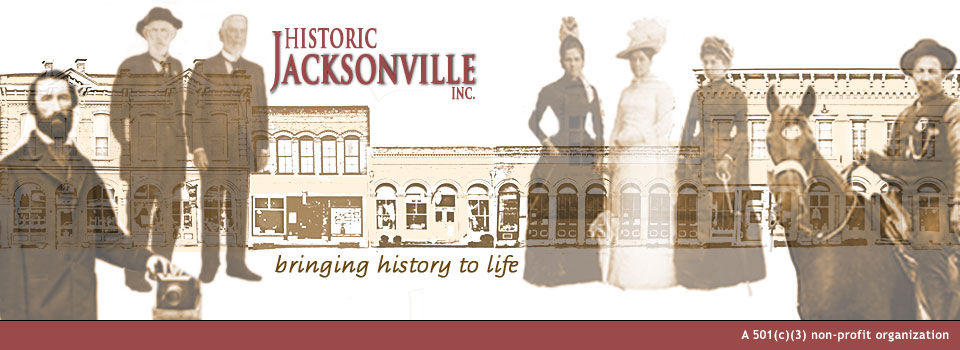
 Jacksonville began in the 1850s as a gold boom town, full of miners, settlers, merchants, and women of ill-repute all seeking a quick fortune. It quickly grew into the largest town in Southern Oregon, and the hub of regional commerce, society, and government for half a century. In fact, the block on Fifth Street, between C and D Streets, has been the site of County, and now City government from at least 1859.
Jacksonville began in the 1850s as a gold boom town, full of miners, settlers, merchants, and women of ill-repute all seeking a quick fortune. It quickly grew into the largest town in Southern Oregon, and the hub of regional commerce, society, and government for half a century. In fact, the block on Fifth Street, between C and D Streets, has been the site of County, and now City government from at least 1859.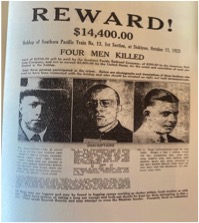 In 1927, the Jacksonville Courthouse had one last glory moment before the county seat was moved to Medford—the trial of the DeAutremont brothers, Hugh and twins Ray and Roy. Four years earlier, they had staged a train robbery which turned to murder. The press had dubbed it the Siskiyou Massacre and the West’s last great train robbery. It attracted nationwide attention and involved a three-year man hunt extending to Mexico, Canada, and the Philippines.
In 1927, the Jacksonville Courthouse had one last glory moment before the county seat was moved to Medford—the trial of the DeAutremont brothers, Hugh and twins Ray and Roy. Four years earlier, they had staged a train robbery which turned to murder. The press had dubbed it the Siskiyou Massacre and the West’s last great train robbery. It attracted nationwide attention and involved a three-year man hunt extending to Mexico, Canada, and the Philippines.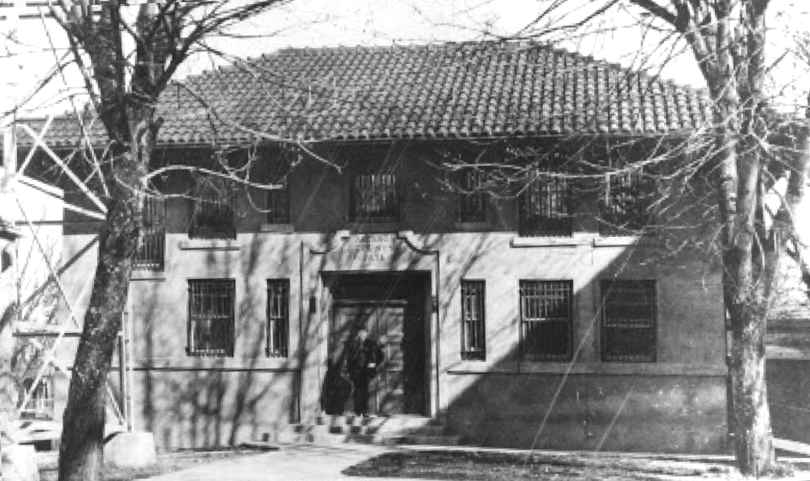 The historic Jackson County Jail, now the home of Art Presence at 216 North 5th Street, stands on the site of three previous jails, each with its own fleeting, and sometimes haunting, history. The original jail was built in the 1850s, probably at the same time as the original courthouse. While all we know about that building is that at least one prisoner was able to escape1 (the beginning of a trend, as we shall see), we can imagine that when it was replaced, it was not in much better condition than the first courthouse, described in Stop 1 of this tour.
The historic Jackson County Jail, now the home of Art Presence at 216 North 5th Street, stands on the site of three previous jails, each with its own fleeting, and sometimes haunting, history. The original jail was built in the 1850s, probably at the same time as the original courthouse. While all we know about that building is that at least one prisoner was able to escape1 (the beginning of a trend, as we shall see), we can imagine that when it was replaced, it was not in much better condition than the first courthouse, described in Stop 1 of this tour.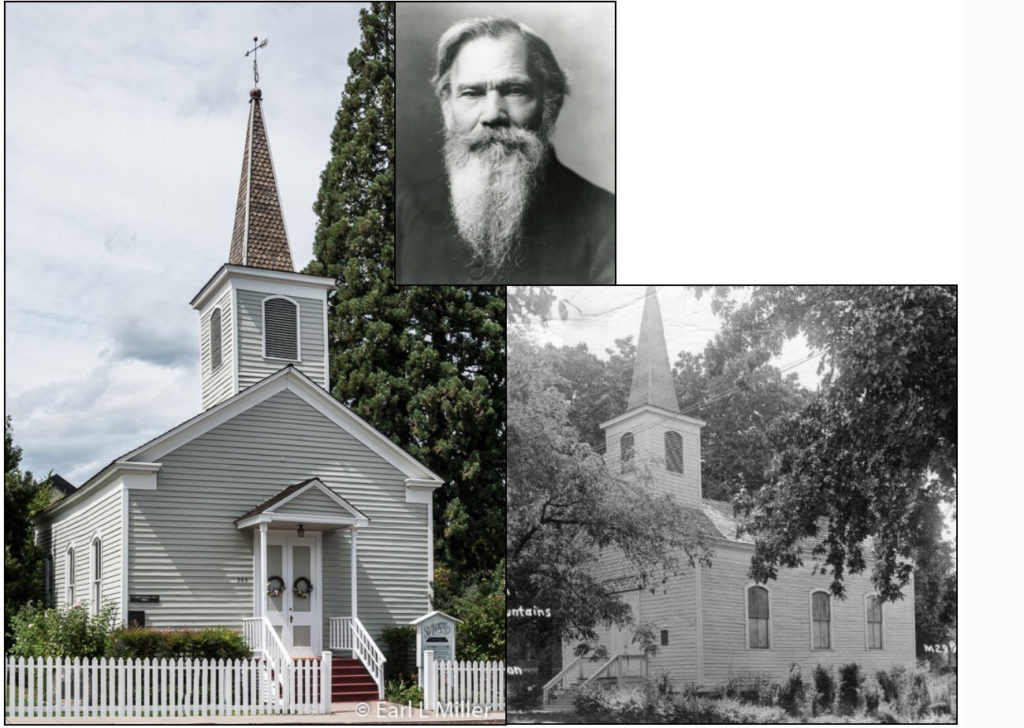
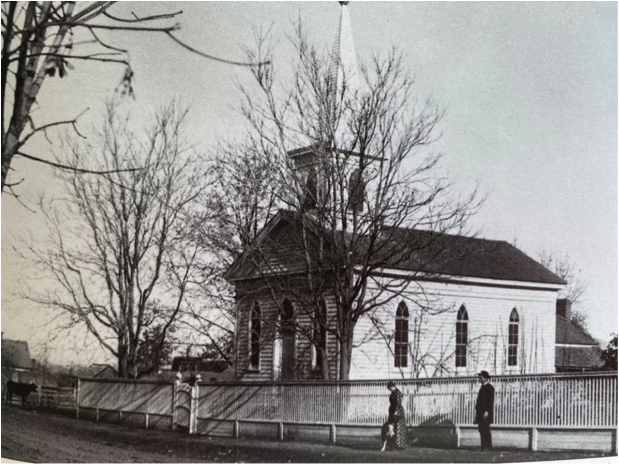
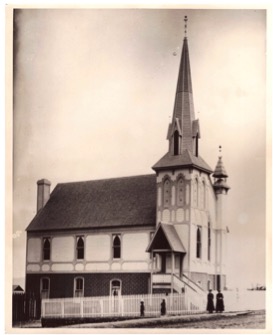
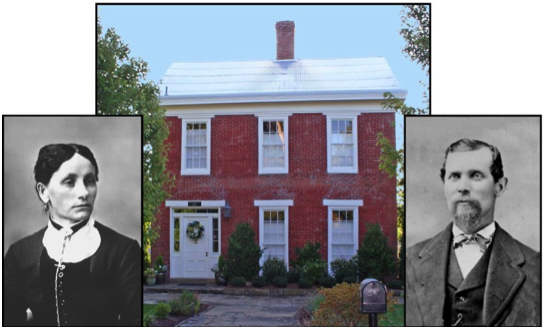
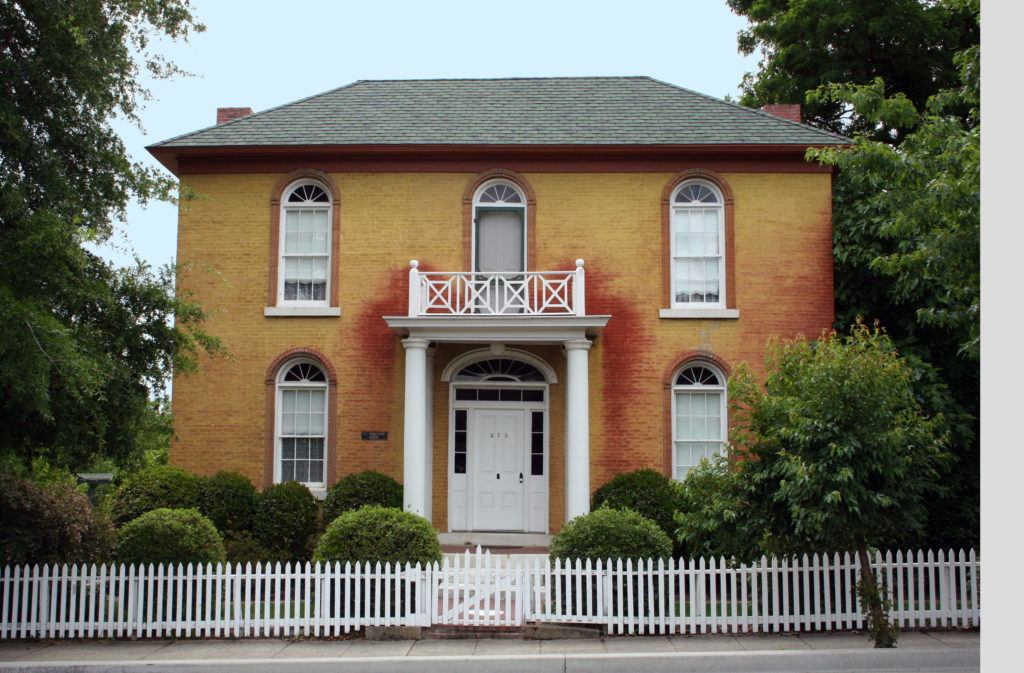
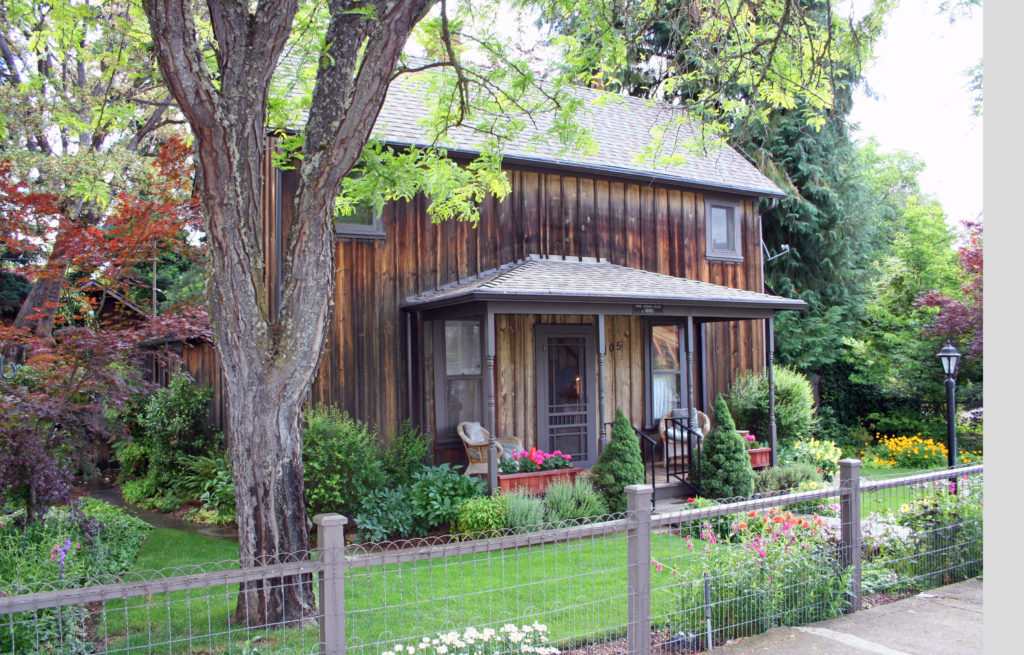

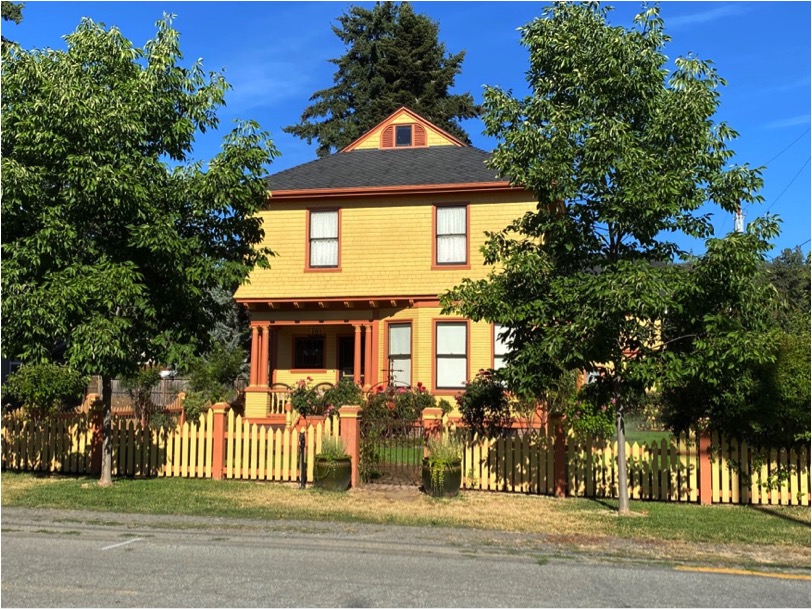
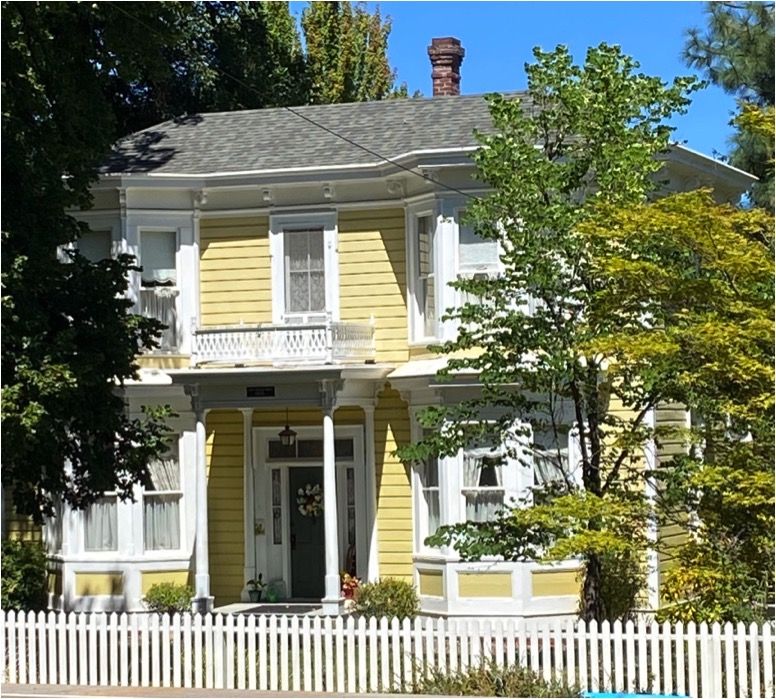
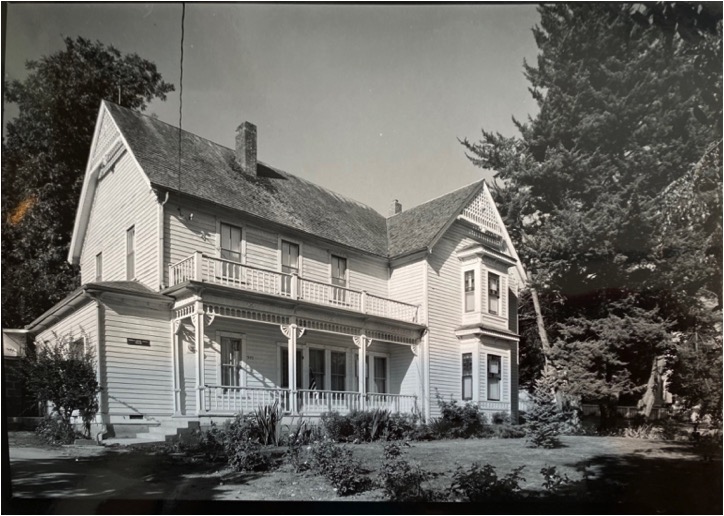
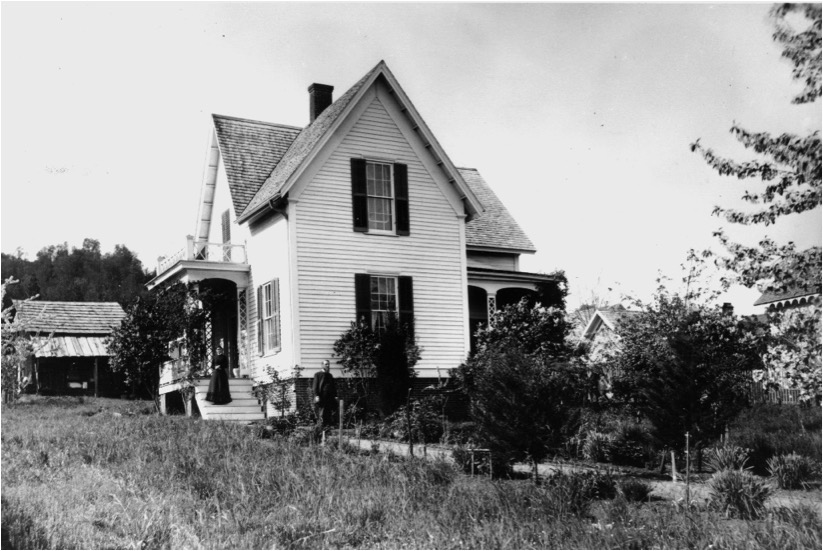
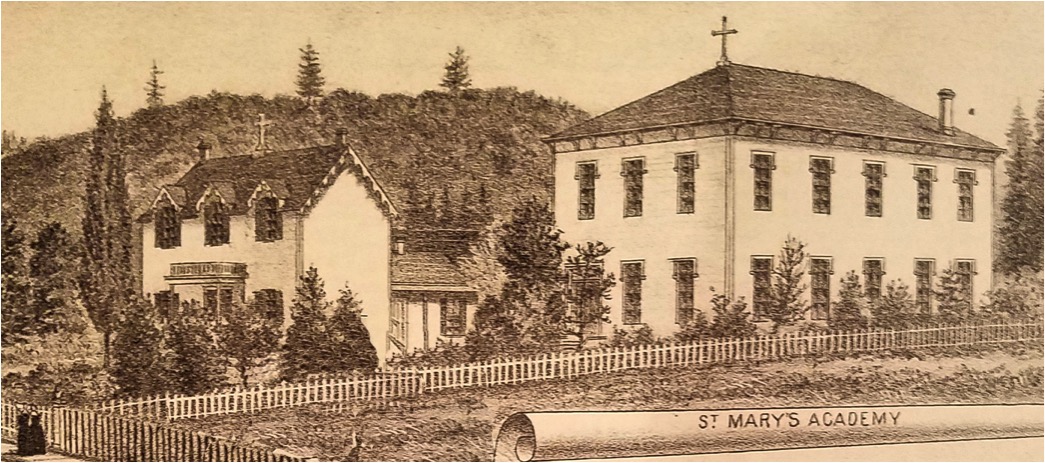
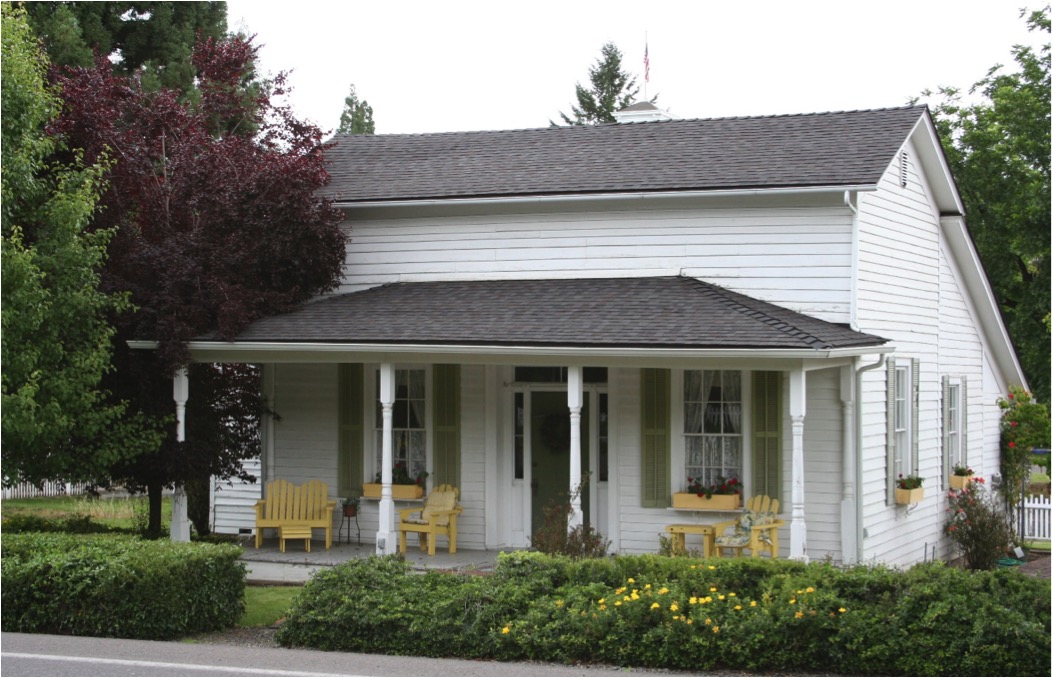
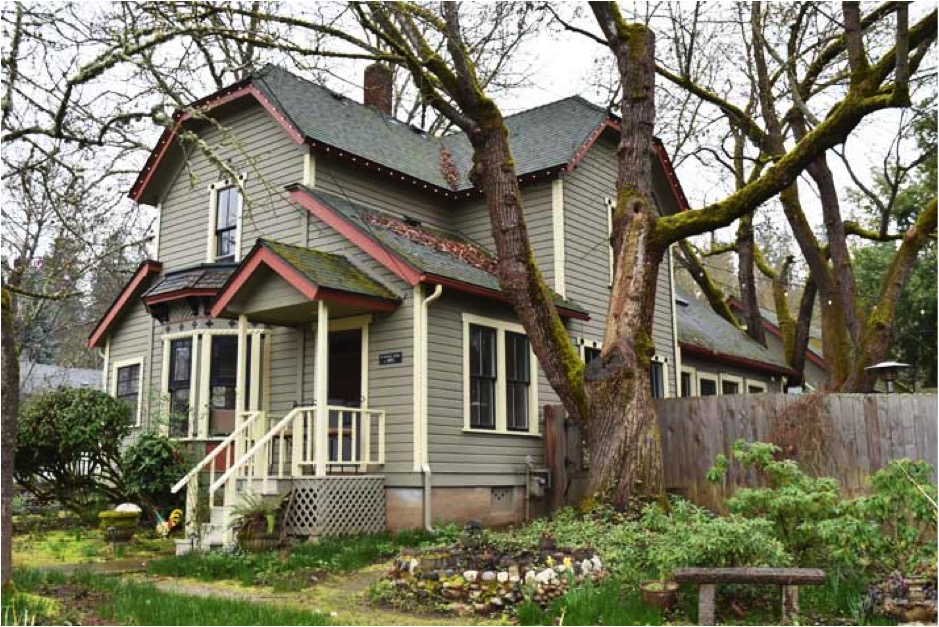
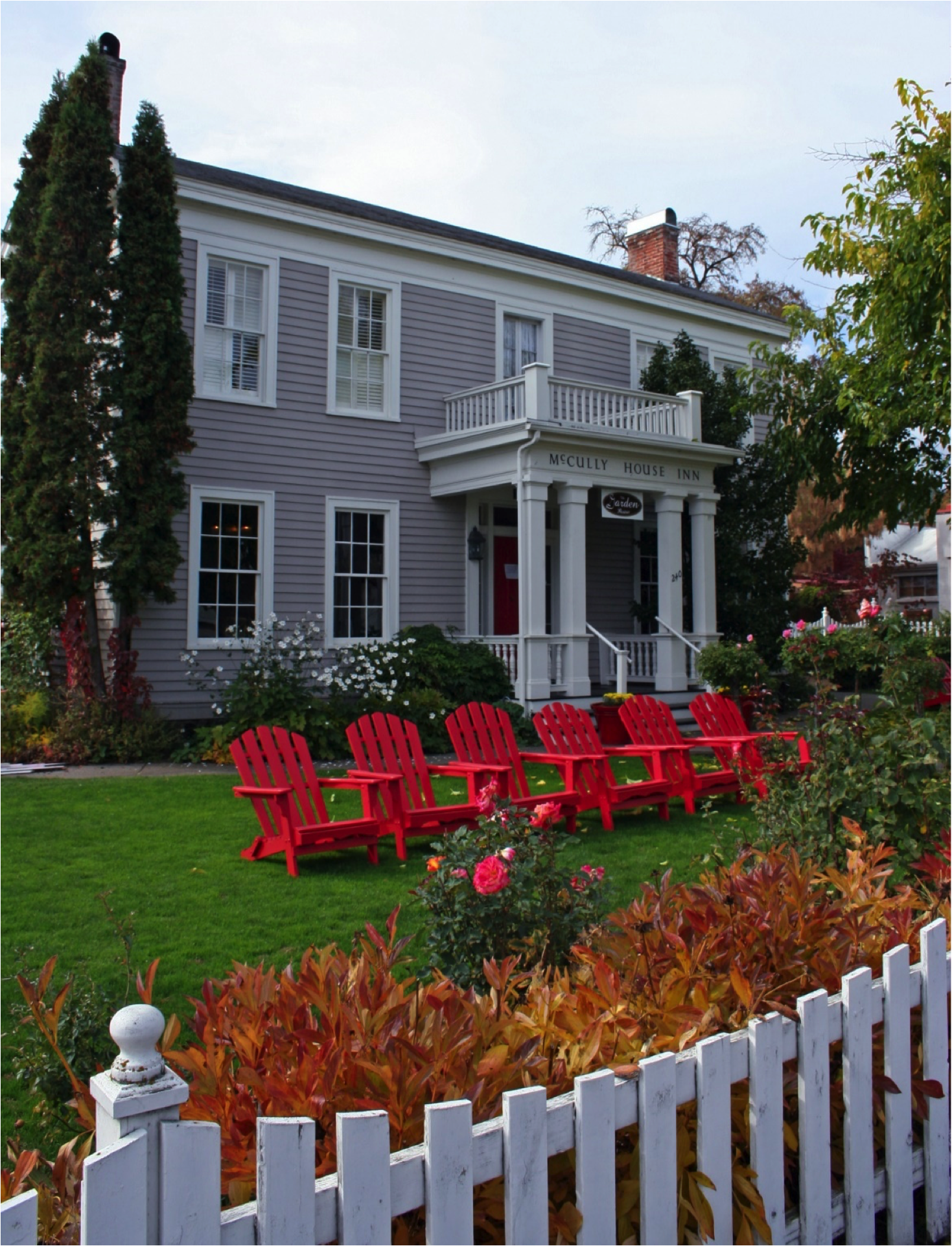
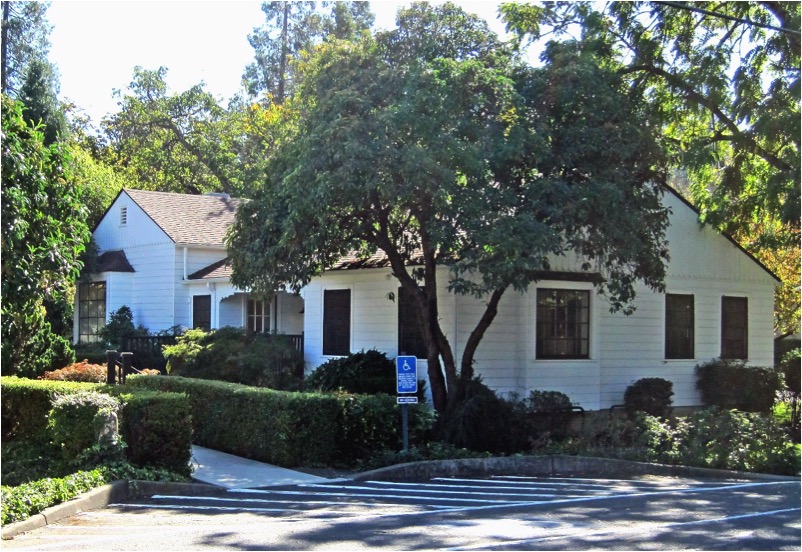
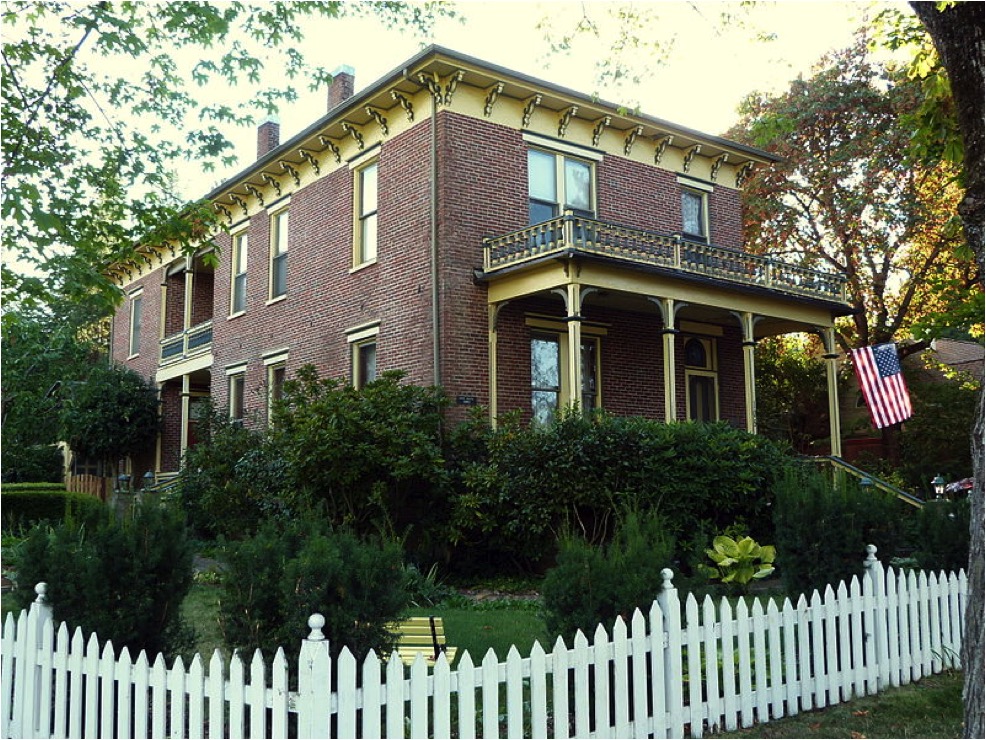
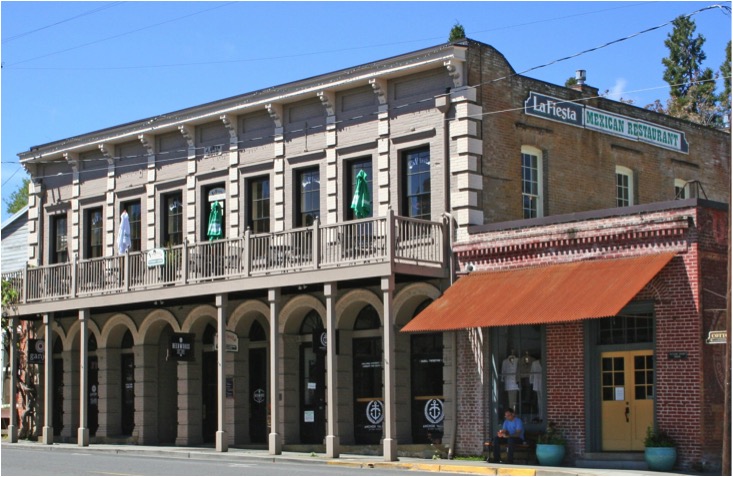
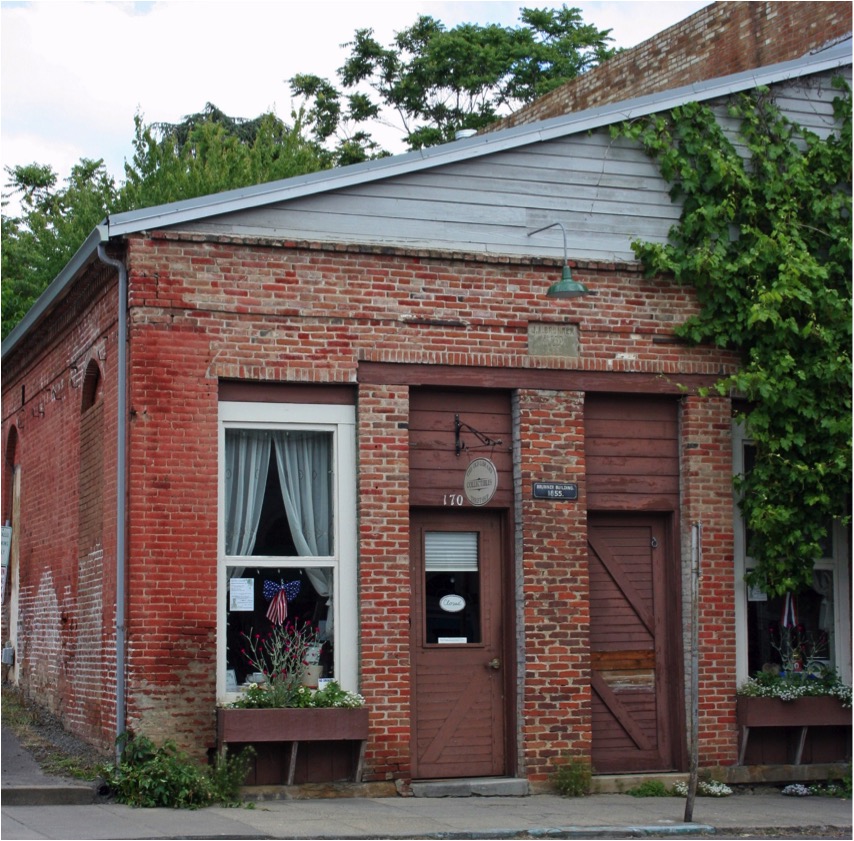

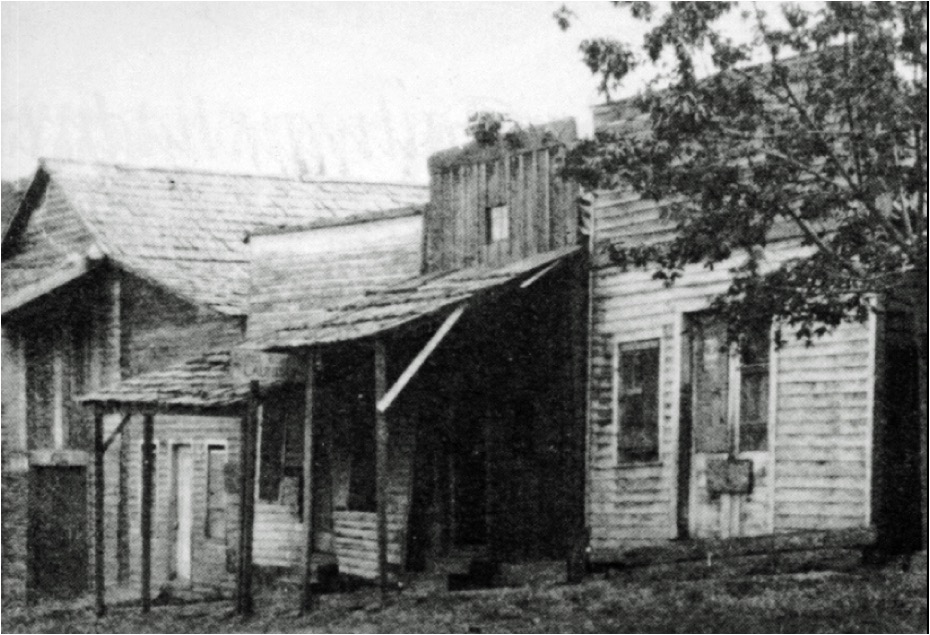
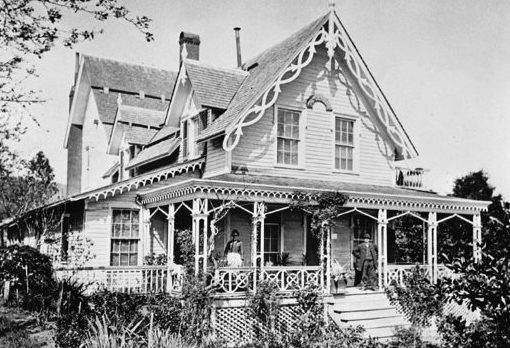
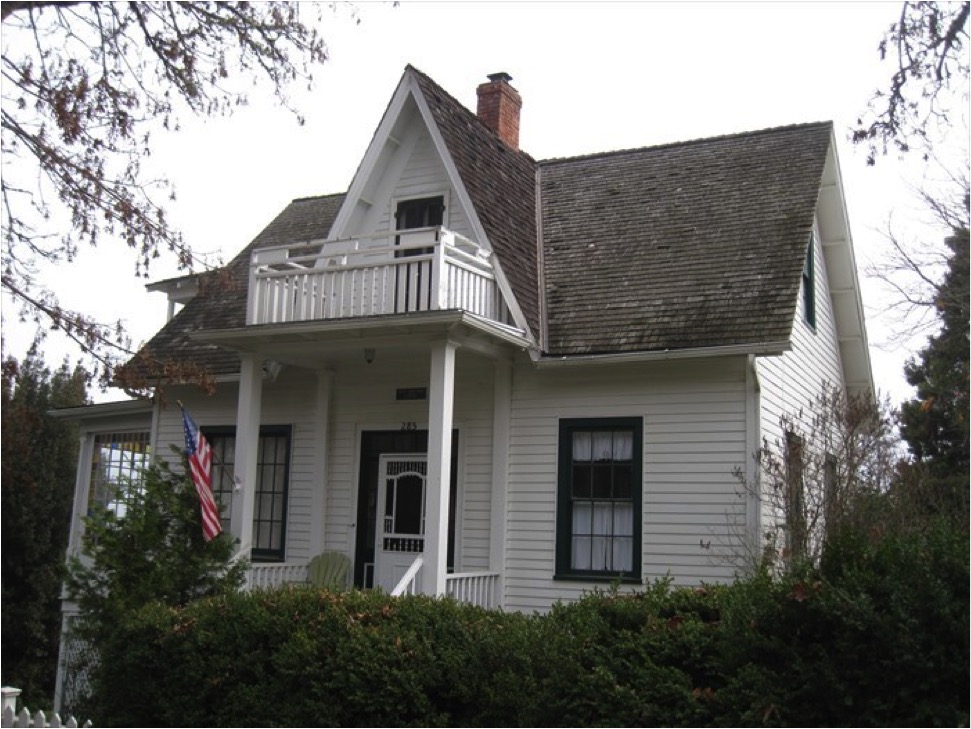
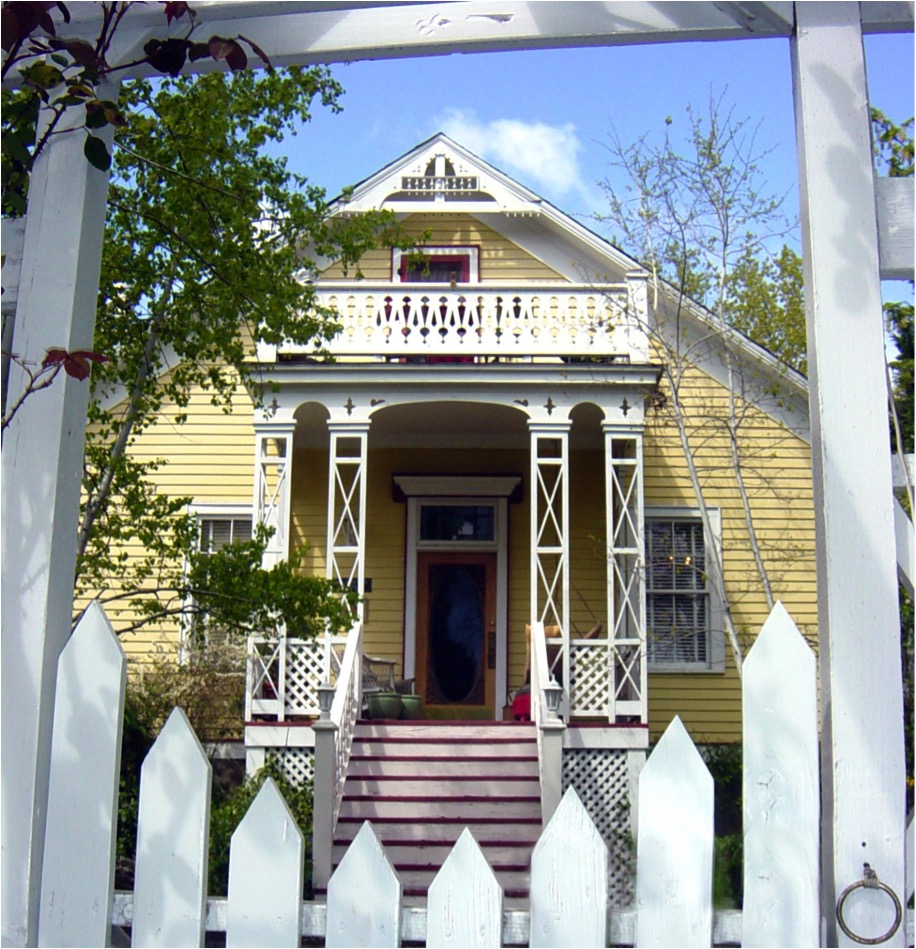
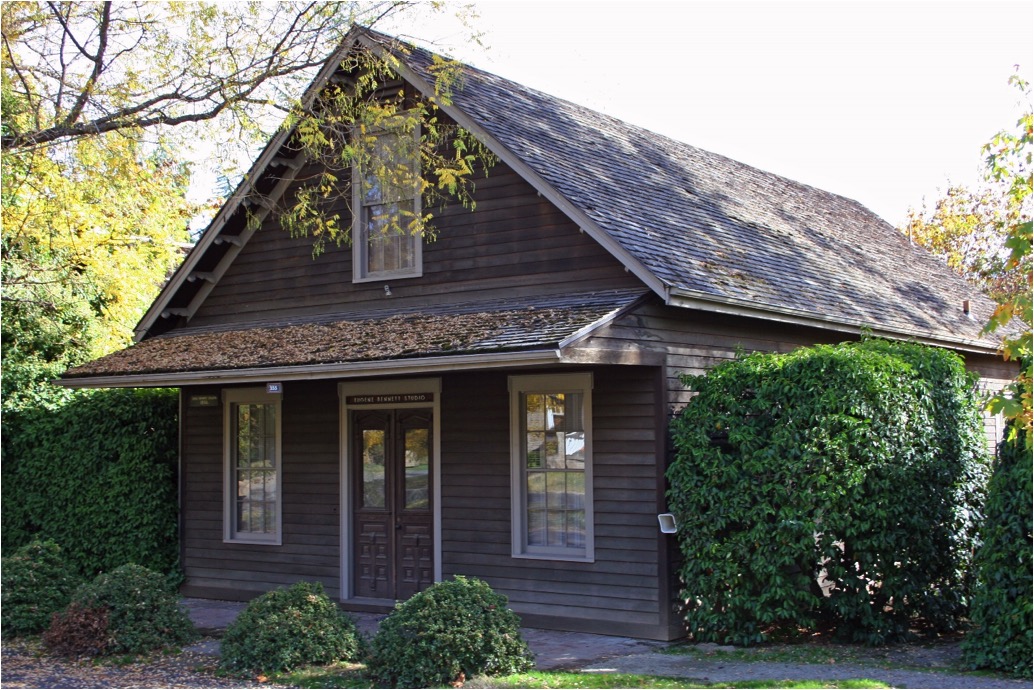
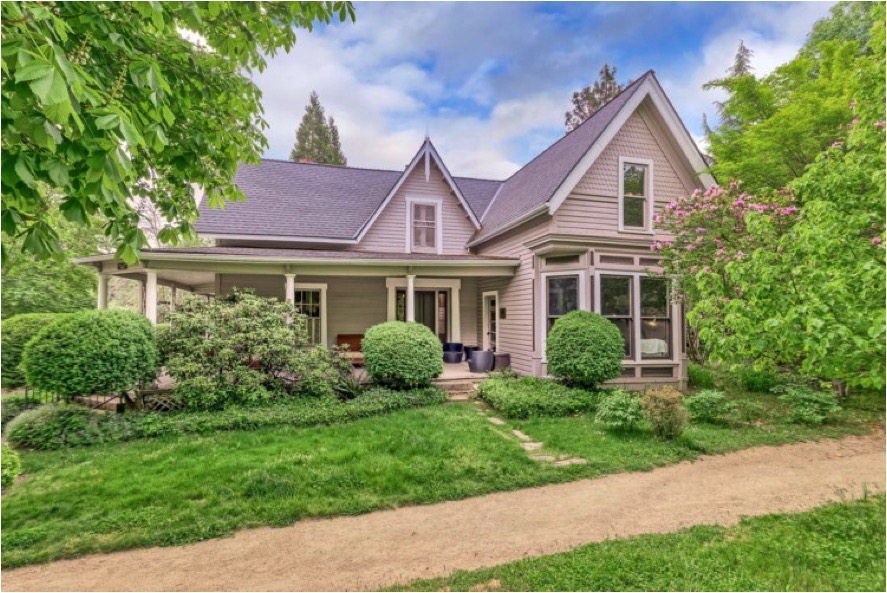
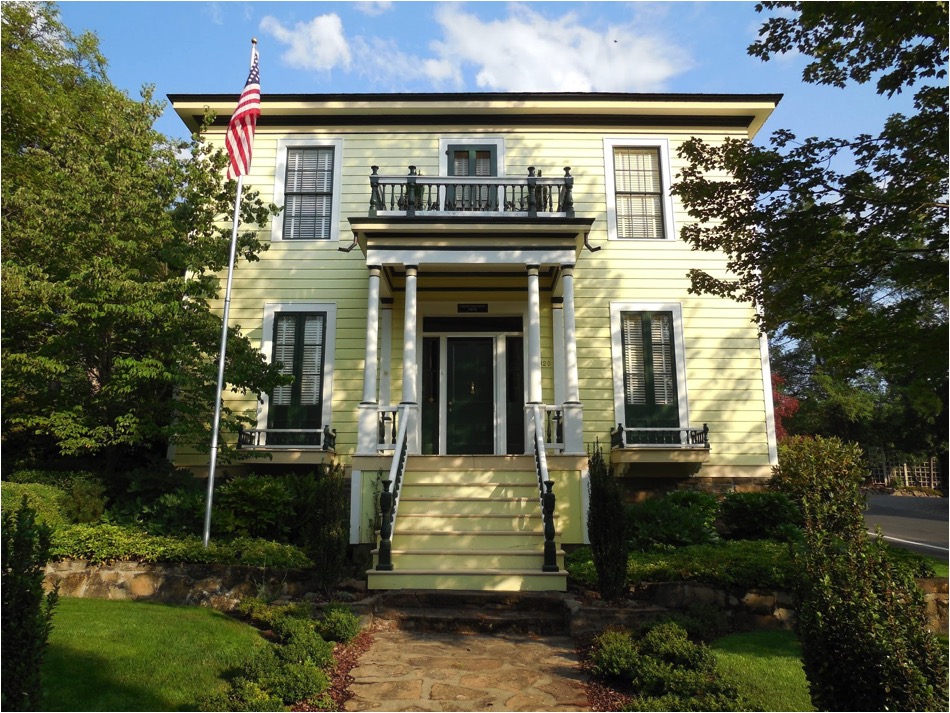
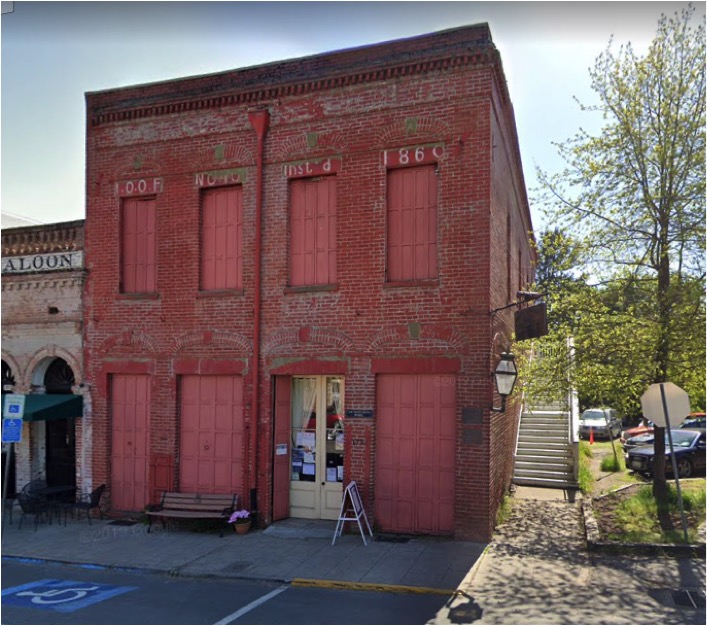
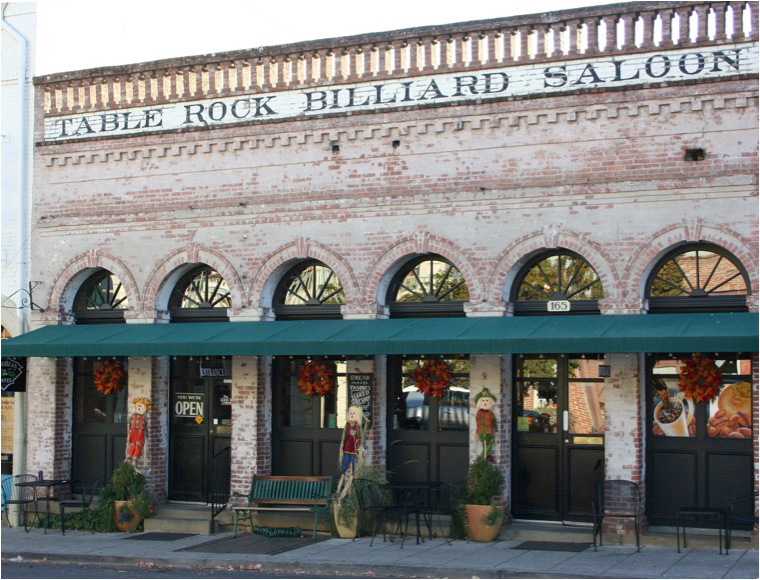
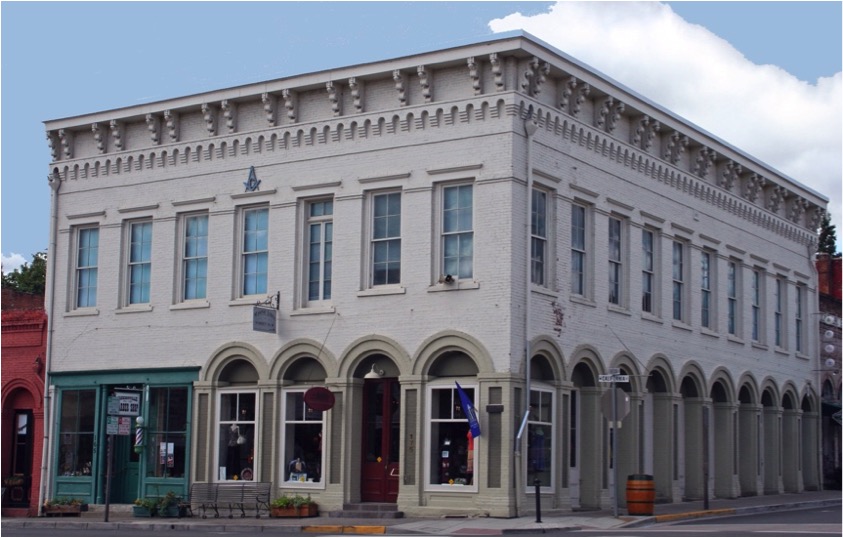
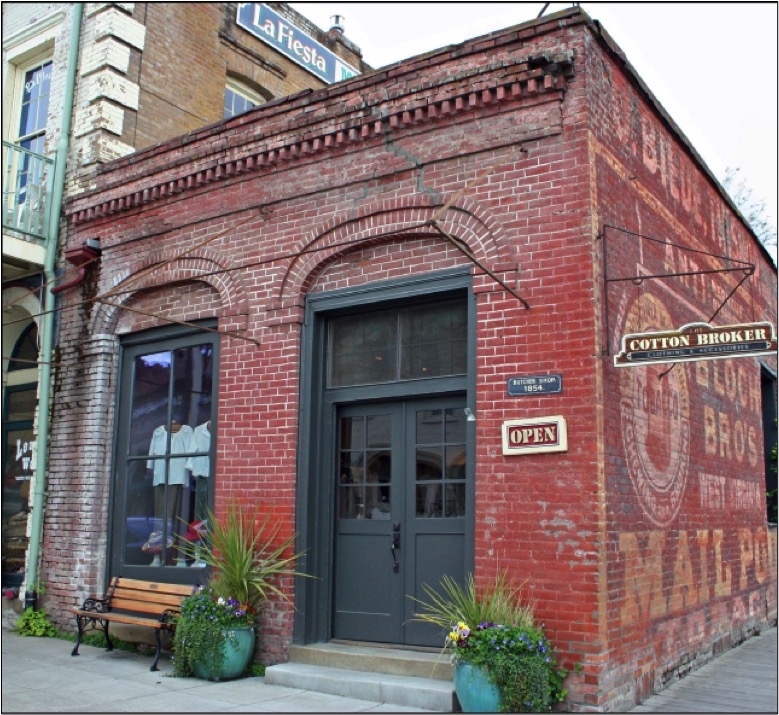
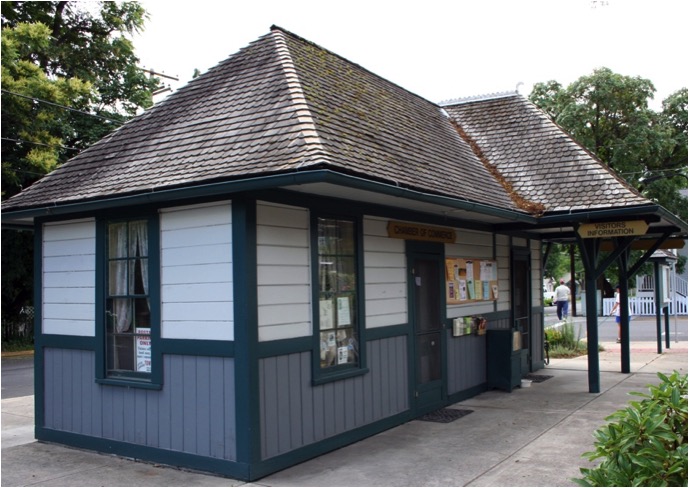 Let’s cross California and walk down to the corner of Oregon and C Street, the current site of the Jacksonville Visitors’ Center. The Visitors’ Center was originally the Rogue River Valley Railway depot.
Let’s cross California and walk down to the corner of Oregon and C Street, the current site of the Jacksonville Visitors’ Center. The Visitors’ Center was originally the Rogue River Valley Railway depot.